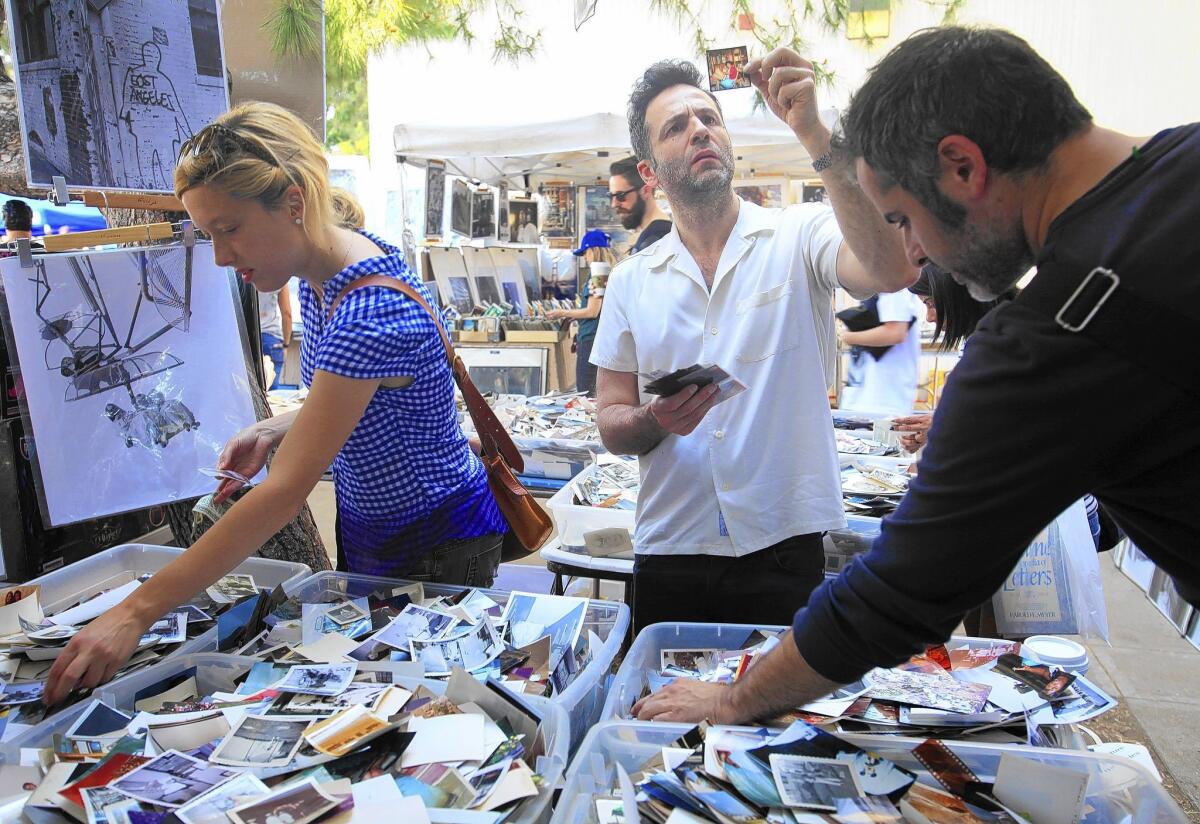For many people, gathering possessions is just the stuff of life

- Share via
We cherish things and accumulate them. We move them from shelf to shelf, and from home to home. The federal government estimates that a quarter of Americans with two-car garages don’t use them for automobiles. Even those without a permanent home carry their stuff around with them.
We like to shop, own, trade or give away. Things matter to us, for reasons practical and emotional.
“Our possessions all have magical qualities. Many, if not most, of the things we keep have an essence that goes beyond the physical character of the object,” says Randy Frost, a professor at Smith College, in Northampton, Mass., who has studied and written about hoarding and is the author of “Stuff.”
A stroll through the Sunday flea market outside Fairfax High School provides a catalog of some of those magical objects: varsity letter jackets, rotary phones, typewriters, fur blankets, old ties and cowboy boots. Butterflies pinned to cardboard and framed. A crystal Eiffel Tower. A blue guitar.
Vendors collect stuff to sell to people, who often resell the stuff all over again.
“This market has the best eclectic stuff — a collection of people’s things that are old,” says LaNell Petersen, shopping on a recent weekend with her sisters. She likes the hunt for something she believes is more valuable than its price.
Consider these statistics cited by professional organizer Regina Lark: The average U.S. household has 300,000 things, from paper clips to ironing boards. U.S. children make up 3.7% of children on the planet but have 47% of all toys and children’s books.
So why can’t we let go? And what are the implications of our reluctance to pare down, our inability to get organized?
The notion that things don’t matter is rubbish, the experts say. They matter for many reasons: keeping up with the Joneses, recalling departed loved ones, even objective value — like the 17th century Dutch painting that is among many objects of desire in Donna Tartt’s “The Goldfinch.”
Our things can give us a sense of security, connection to the past, to the people we love.
“When you go home in the evening after work, you go in your house and you feel comfort because you have your stuff,” Frost says.
But that security may be a crutch too, “a sort of public artificial mask,” says Andrew Mellen, a professional organizer and author of “Unstuff Your Life.” “Full bookshelves say, ‘I’m well-read. I have lots of books.’ But really, you just buy books. Is your home an accurate external reflection of you?”
Lark had bookcases full of the books she used to earn a doctorate in history. When she downsized to an apartment, she looked at the volumes and came to the conclusion that they represented her accomplishment, her intelligence. As she decided what to keep, “I had to ask myself a lot of questions. Who am I without these books? What will people think of me? Getting rid of them, am I less smart?”
Finally, she passed them on to a younger doctoral student and says she’s happier for it.
But there’s no single prescription: “One person is happy living in a sparsely furnished yurt,” says Gretchen Rubin, who devoted a chapter of her book “Happier at Home” to assessing her possessions, “while another person is happy adding to a collection of fine porcelain. There’s no one right way.”
“I don’t think stuff is inherently wrong or bad,” Mellen says, “but if things have become obstacles to your happiness, that’s a problem.”
Figuring out what to discard and being able to actually toss stuff is crucial to an ordered, happy life, experts say.
“I am impressed by the degree to which outer order controls inner calm,” says Rubin. She recalls the friend who told her, “‘I cleaned out my fridge, and now I can change careers.’”
Among our keepsake possessions, photos have their own “symbolic weight,” prompting people to save even pictures of people they no longer remember, Rubin says.
Eventually many of them end up in the trash — unless Mark Kologi gets his hands on them. For 17 years now, artists in need of inspiration and all sorts of other people have found their way to his flea market stall to root through bins of miscellaneous snapshots, most of which sell for 50 cents apiece. He estimates he’s sold millions over the years. “They don’t belong in the garbage,” he says.
Some have been bought by Luiso Berdejo, who was inspired to make the film “Violet” by one picture. In the film, a young man falls in love with a woman he sees in a photo from that stall and sets out to find her.
As Berdejo talks, another customer encourages a friend to “just reach in and pull one out.” You never know where it might lead.







